2020.07.15
Japanese Auspicious Patterns

Japanese traditional patterns have long been cherished through the long history of Japan. They can still be found in various life scenes, such as traditional events and vessels.
Among them, “Kisshou Mon’you” or auspicious omen motifs are considered especially good, but you may feel further attached to them if you learn their meanings and background stories. Let us show you some of them:
Shippou (linked circles): Seven treasures of Buddhism. In this pattern, linked circles expand in all directions, and the words “shihou happou,” meaning “all directions,” are said to be the phonetic origin of this pattern. This auspicious omen motif represents harmony and expansion.
Asa no ha (flax leaf): A geometric pattern with linked hexagons. Because the flax plant grows strongly, this pattern has commonly been used in children’s clothing. It was very popular in the latter half of the Edo Era when the pattern was used by kabuki actors in their stage costumes.
Seigaiha (blue ocean waves): Used in the costume for the ancient court performance of gagaku, entitled “Seigaiha.” The pattern has the motif of waves expanding indefinitely in prayer for a long-lasting peaceful life. Originally used in ancient Persia, the pattern was transported via the Silk Road and introduced to Japan during the Asuka Era around the seventh century.